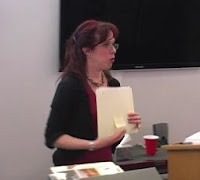1. Letter sized manuscript boxes - Boxes come in every shape and size you can imagine, but "standard" manuscript boxes are most useful for the majority of items. I store documents, ephemera, and photos in these boxes. If you can do nothing else with your prized family papers, place them in a box to keep out dust and light and to afford some protection to your items. Consider purchasing special sized boxes for oversized materials, smaller photos, and other irregular items. (Albums are an expensive alternative to boxes for photos, but are a nice edition for images you prize and frequently view.)
2. Folders - If you can only afford two items to care for your personal materials, second up on your supply list right after boxes should be folders. Folders help you give order to your materials and provide some support for items. Placing similar materials in a folder allows you to easily find things. Label folders to assist with your organization. You can even use folders creatively to support other folders.

3. "Interleaving" paper - Sometimes items in your collection need to be separated from others because of a little problem you notice. For example, the booklet to the left includes images with unstable red ink that bleeds from one page to the other. I have placed thin buffered paper sheets between pages so that when that ink migrates, if it continues to migrate, it will affect the interleaving sheet rather than the opposite page. I use interleaving sheets in folders too to separate different kinds of paper. I also fold these plain white sheets in half to make envelopes for small items or to use in place of paper clips and staples to keep items together within a folder.

 4. Microspatula - I love my microspatula! I joke in presentations about my handy husband's tools. I am not a terribly mechanical kind of girl (at least in my own mind I'm not when I compare myself to my husband.) I have my garden tools (the non-motorized kind); I have camera equipment; and I have a microspatula. This tool is a small metal spatula that can be used to remove staples and to help you peel photos off sticky "magnetic" album. It is very useful and can save a lot of time and frustration.
4. Microspatula - I love my microspatula! I joke in presentations about my handy husband's tools. I am not a terribly mechanical kind of girl (at least in my own mind I'm not when I compare myself to my husband.) I have my garden tools (the non-motorized kind); I have camera equipment; and I have a microspatula. This tool is a small metal spatula that can be used to remove staples and to help you peel photos off sticky "magnetic" album. It is very useful and can save a lot of time and frustration.3. Pencil / safe pen - Every photo in your collection should be labeled, either directly on the back of the image, on a label on the back of the image, or on the supplies in which you store your materials. Some people do not like to directly mark their photos. A basic tenet of archives management is "never do anything that is irreversible." So instead of writing on a photo, some people prefer to write on the album or a plastic sleeve that contains the photo. I've seen too many images separated from their storage supplies, so I belong to the camp that says go ahead and write on the back of the photo CAREFULLY. Be sure to use a pencil, if the surface is not too slick or purchase a special pen that will not harm your photo collection. (Some inks will "eat" your images and bleed through because of their acidity.) Be sure to not press too hard when you write on the back of your images. Include the names of the people pictured in the image, where and when it was taken and even how you know the people. The more information you can include in your labeling, the better for future family historians.
Happy "archiving"!
Images in this post were taken from a filmed presentation of my "Unofficial Family Archivist" talk by Derry Community Television. I'd like to give them special thanks for their work. See excerpts from my presentation on YouTube.



Thanks for this overview. You're talking to me!!!
ReplyDelete;) I hoped I was!
ReplyDeleteExcellent post sharing by you...
ReplyDeletecafe equipment suppliers sydney